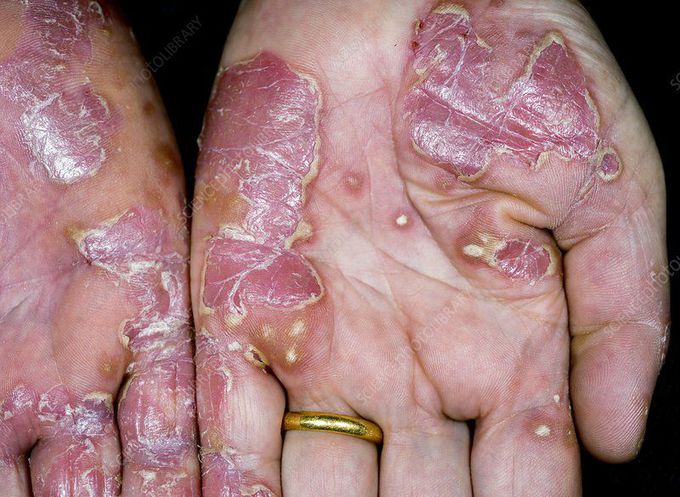


PSORIASIS
Psoriasis is a chronic autoimmune condition that causes the rapid buildup of skin cells. This buildup of cells causes scaling on the skin’s surface. Inflammation and redness around the scales is fairly common. Typical psoriatic scales are whitish-silver and develop in thick, red patches. Sometimes, these patches will crack and bleed. Psoriasis is the result of a sped-up skin production process. Typically, skin cells grow deep in the skin and slowly rise to the surface. Eventually, they fall off. The typical life cycle of a skin cell is one month. In people with psoriasis, this production process may occur in just a few days. Because of this, skin cells don’t have time to fall off. This rapid overproduction leads to the buildup of skin cells. Scales typically develop on joints, such elbows and knees. They may develop anywhere on the body, including the: hands feet neck scalp face Less common types of psoriasis affect the nails, the mouth, and the area around genitals. According to one study, around 7.4 million Americans have psoriasis. It’s commonly associated with several other conditions, including: type 2 diabetes inflammatory bowel disease heart disease psoriatic arthritis anxiety depression What are the different types of psoriasis? There are five types of psoriasis: Plaque psoriasis Plaque psoriasis is the most common type of psoriasis. The American Academy of Dermatology (AAD) estimates that about 80 percent of people with the condition have plaque psoriasis. It causes red, inflamed patches that cover areas of the skin. These patches are often covered with whitish-silver scales or plaques. These plaques are commonly found on the elbows, knees, and scalp. Guttate psoriasis Guttate psoriasis is common in childhood. This type of psoriasis causes small pink spots. The most common sites for guttate psoriasis include the torso, arms, and legs. These spots are rarely thick or raised like plaque psoriasis. Pustular psoriasis Pustular psoriasis is more common in adults. It causes white, pus-filled blisters and broad areas of red, inflamed skin. Pustular psoriasis is typically localized to smaller areas of the body, such as the hands or feet, but it can be widespread. Inverse psoriasis Inverse psoriasis causes bright areas of red, shiny, inflamed skin. Patches of inverse psoriasis develop under armpits or breasts, in the groin, or around skinfolds in the genitals. Erythrodermic psoriasis Erythrodermic psoriasis is a severe and very rare type of psoriasis. This form often covers large sections of the body at once. The skin almost appears sunburned. Scales that develop often slough off in large sections or sheets. It’s not uncommon for a person with this type of psoriasis to run a fever or become very ill. This type can be life-threatening, so individuals should see a doctor immediately. What are the symptoms? Psoriasis symptoms differ from person to person and depend on the type of psoriasis. Areas of psoriasis can be as small as a few flakes on the scalp or elbow, or cover the majority of the body. The most common symptoms of plaque psoriasis include: red, raised, inflamed patches of skin whitish-silver scales or plaques on the red patches dry skin that may crack and bleed soreness around patches itching and burning sensations around patches thick, pitted nails painful, swollen joints Not every person will experience all of these symptoms. Some people will experience entirely different symptoms if they have a less common type of psoriasis. Most people with psoriasis go through “cycles” of symptoms. The condition may cause severe symptoms for a few days or weeks, and then the symptoms may clear up and be almost unnoticeable. Then, in a few weeks or if made worse by a common psoriasis trigger, the condition may flare up again. Sometimes, symptoms of psoriasis disappear completely. When you have no active signs of the condition, you may be in “remission.” That doesn’t mean psoriasis won’t come back, but for now you’re symptom-free. Diagnosing psoriasis Two tests or examinations may be necessary to diagnose psoriasis. Physical examination Most doctors are able to make a diagnosis with a simple physical exam. Symptoms of psoriasis are typically evident and easy to distinguish from other conditions that may cause similar symptoms. During this exam, be sure to show your doctor all areas of concern. In addition, let your doctor know if any family members have the condition. Biopsy If the symptoms are unclear or if your doctor wants to confirm their suspected diagnosis, they may take a small sample of skin. This is known as a biopsy. The skin will be sent to a lab, where it’ll be examined under a microscope. The examination can diagnose the type of psoriasis you have. It can also rule out other possible disorders or infections. Most biopsies are done in your doctor’s office the day of your appointment. Your doctor will likely inject a local numbing medication to make the biopsy less painful. They will then send the biopsy to a lab for analysis. When the results return, your doctor may request an appointment to discuss the findings and treatment options with you. Medications Some medications are considered psoriasis triggers. These medications include: lithium antimalarial medications high blood pressure medication Treatment options for psoriasis Psoriasis has no cure. Treatments aim to reduce inflammation and scales, slow the growth of skin cells, and remove plaques. Psoriasis treatments fall into three categories: Topical treatments Creams and ointments applied directly to the skin can be helpful for reducing mild to moderate psoriasis. Topical psoriasis treatments include: topical corticosteroids topical retinoids anthralin vitamin D analogues salicylic acid moisturizer Systemic medications People with moderate to severe psoriasis, and those who haven’t responded well to other treatment types, may need to use oral or injected medications. Many of these medications have severe side effects. Doctors usually prescribe them for short periods of time. These medications include: methotrexate cyclosporine (Sandimmune) biologics retinoids Light therapy This psoriasis treatment uses ultraviolet (UV) or natural light. Sunlight kills the overactive white blood cells that are attacking healthy skin cells and causing the rapid cell growth. Both UVA and UVB light may be helpful in reducing symptoms of mild to moderate psoriasis. Most people with moderate to severe psoriasis will benefit from a combination of treatments. This type of therapy uses more than one of the treatment types to reduce symptoms. Some people may use the same treatment their entire lives. Others may need to change treatments occasionally if their skin stops responding to what they’re using.
How do you tell the difference between psoriasis and eczema??
How Psoriasis & Eczema Feel Different Eczema causes an intense itch. It can get so bad that you scratch enough to make your skin bleed. Psoriasis could also be itchy, but there's something extra going on. Your skin may sting or burn. Some people say it feels like you're getting bitten by fire ants. The Differences In Appearances Eczema makes your skin red and inflamed. It may be scaly, oozing, or crusty. You may see rough, leathery patches that are sometimes dark. It can also cause swelling. Psoriasis can also cause red patches. They may be silvery and scaly -- and raised. But if you look closely, the skin is thicker and more inflamed than with eczema. Where They Show Up Eczema often appears on parts of your body that bend, like your inner elbow or behind your knees. You can have it on your neck, wrists, and ankles. Babies sometimes get it on their chin, cheeks, scalp, chest, back, arms, and legs. Psoriasis often shows up on places like your: Elbows Knees Scalp and face Lower back Palms of your hands Soles of your feet You may also have patches on other areas, such as: Fingernails and toenails Mouth and lips Eyelids Ears Skin folds What Triggers Them Eczema usually results from things that irritate your skin, like: Soaps Detergents Disinfectants Juices from produce or meats Things that cause allergies can also set off eczema, like: Dust Pets Pollen Mold Dandruff Some foods Infections can start up eczema, and so can stress, sweating, heat, humidity, and changes in your hormones. Psoriasis shares some of these triggers, like stress and infection. But you can also get flare-ups when your skin is injured, for example by: Vaccination Sunburn Scratches Some medications can also bring on a psoriasis flare, like lithium, which treats bipolar disorder, or drugs for malaria. At What Age Do They Start? Eczema usually starts in babies or young children. Often, symptoms improve when a kid becomes a grown-up. It's less common, but possible, to get it as an adult. When that happens, it's usually because you have another condition like thyroid disease, hormone changes, or stress. Psoriasis, on the other hand, usually shows up between ages 15 and 35. But you can get it at other ages too. It's rare for a baby to have it. Conditions They're Linked To Eczema usually comes along with dry, sensitive skin. You may have someone in your family who has it or has asthma or hay fever. Psoriasis is linked to other serious health conditions. If you have it, you may also have diabetes, heart disease, or depression. Whether it's psoriasis or eczema, your doctor can recommend ways to get relief for it. How Is Each Treated Eczema treatment depends on how severe it is. For mild to moderate cases, you’ll use a topical corticosteroid to control inflammation, and you’ll use an emollient on your skin. This type of moisturizer has an oil or cream base, not a water base, like lotion, which could dry your skin out more. If you have moderate to severe eczema, you may need to try a medicine that affects your immune system like , methotrexate, azathioprine, or cyclosporine. If nothing else works, your doctor may prescribe a biologic drug called dupilumab (Dupixent). You might also try light therapy (your doctor will call it phototherapy) using ultraviolet light. Psoriasis treatment is either systemic, which means it affects your entire body, or topical, which goes on your skin. If your disease is limited, or mild, you may be able to control it with topical corticosteroids and emollients. Light therapy paired with methotrexate, cyclosporine, acretin, apremilast or a biologic is also an option for more severe cases. Or you could use just a biologic drug, which includes: Adalimumab Brodalumab Etanercept Infliximab Certolizumab pegol Ustekinumab Risankizumab Secukinumab Ixekizumab Guselkumab Tildrakizumab
Excellent medical presentation of Psoriasis with emphasis on the different aspects of different forms of this autoimmune disease.


